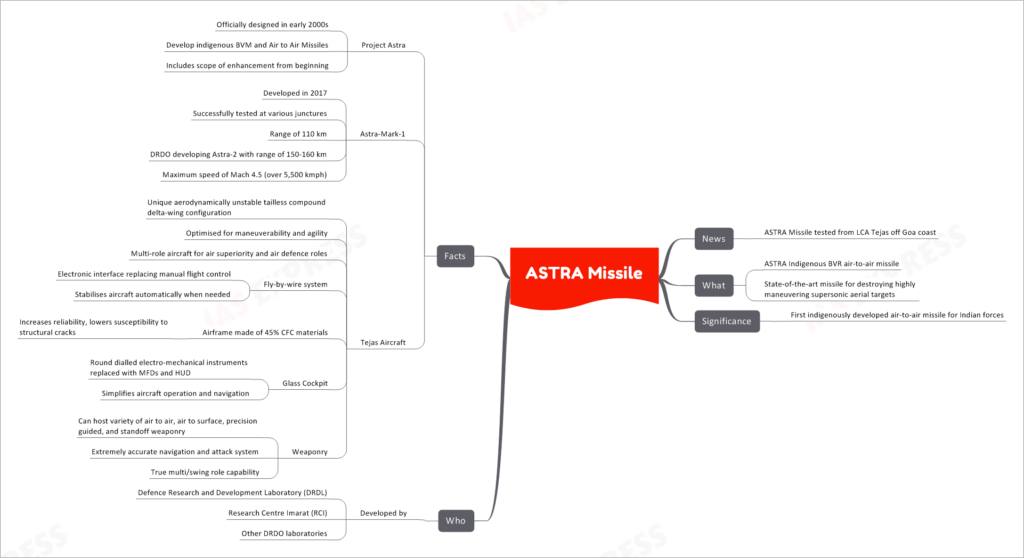ASTRA Missile

The recent successful testing of the ASTRA missile from the LCA Tejas aircraft off the Goa coast marks a significant achievement in India’s indigenous defence capabilities.
News: ASTRA Missile Test Elevates India’s Defence Potential
The recent testing of the ASTRA missile from the LCA Tejas aircraft serves as a testament to India’s progress in developing advanced air-to-air missile systems.
ASTRA Missile: A Game-Changing Innovation
Defining the ASTRA Missile
The ASTRA missile stands as an indigenous Beyond Visual Range (BVR) air-to-air missile, designed to target and eliminate highly maneuvering supersonic aerial threats.
Unveiling its Significance
The missile’s successful development represents a landmark achievement, as it becomes the first indigenously developed air-to-air missile for the Indian armed forces.
Driving Forces Behind ASTRA
Innovators and Developers
The ASTRA missile owes its existence to the collaborative efforts of various Defence Research and Development Organisation (DRDO) laboratories, including the Defence Research and Development Laboratory (DRDL) and the Research Centre Imarat (RCI), along with other contributing units.
Project Astra: Laying the Foundation
The inception of Project Astra in the early 2000s was marked by a mission to develop indigenous Beyond Visual Range Missiles (BVM) and Air-to-Air Missiles. From its inception, the project embraced a scope for continuous enhancement and improvement.
Exploring ASTRA’s Features and Capabilities
ASTRA-Mark-1: An Achievement in Precision
Developed in 2017, the ASTRA-Mark-1 missile boasts a range of 110 km and has been successfully tested on numerous occasions. Its speed, reaching Mach 4.5 (over 5,500 kmph), demonstrates its swift and formidable nature.
The Future with ASTRA-2
Building on the success of the ASTRA-Mark-1, DRDO is currently developing the ASTRA-2, set to possess an extended range of 150-160 km. This advancement is poised to enhance India’s air defence capabilities even further.
Integration with LCA Tejas: A Synergistic Partnership
The Unique Tejas Aircraft
The LCA Tejas aircraft, equipped with a distinctive aerodynamically unstable tailless compound delta-wing configuration, is optimized for superior maneuverability and agility.
A Multifaceted Role
Designed as a multi-role aircraft for air superiority and air defence roles, the Tejas aircraft showcases advanced features that underscore its versatility.
Precision with Fly-by-Wire
The Tejas aircraft employs a sophisticated fly-by-wire system, replacing manual flight control with an electronic interface. This system ensures automatic stabilization when required, enhancing aircraft control.
Advancements in Material and Cockpit Design
The Tejas aircraft’s airframe is crafted from 45% Carbon Fiber Composite (CFC) materials. This composition enhances reliability and reduces susceptibility to structural cracks. The cockpit’s transformation from round-dialled electro-mechanical instruments to Multi-Functional Displays (MFDs) and a Heads-Up Display (HUD) streamlines operations and navigation.
Weaponry and Capabilities
The Tejas aircraft stands as a host for a diverse range of weaponry, including air-to-air, air-to-surface, precision-guided, and standoff munitions. It possesses an exceptional navigation and attack system, offering true multi/swing role capabilities.
If you like this post, please share your feedback in the comments section below so that we will upload more posts like this.

